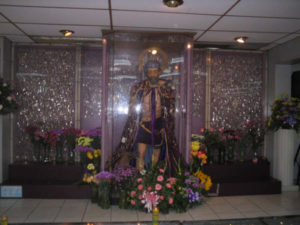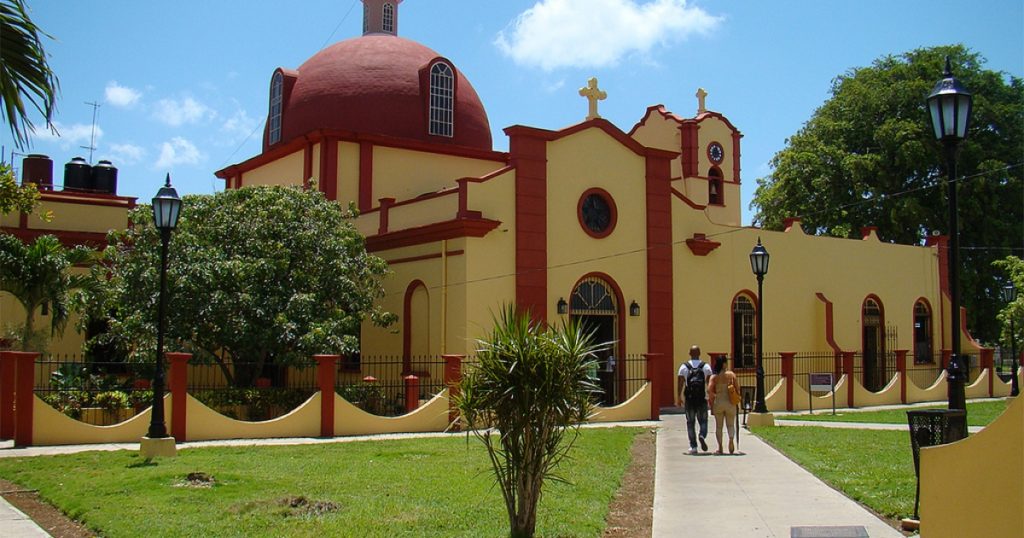 SAN LAZARO O BABALU AYÉ Y SU SANTUARIO EN SANTIAGO DE LAS VEGAS. PHOTOS.
SAN LAZARO O BABALU AYÉ Y SU SANTUARIO EN SANTIAGO DE LAS VEGAS. PHOTOS.
TODOS LOS PELEGRINOS catolicos cubanos que veneran al que identifican como San Lazaro y los santeros como Babalu Ayé, se reunen un dia antes del 17 de Diciembre para venerar al Santo en su iglesia que es un poco más que una ermita de el Rincón en Santiago de las Vegas, al suroeste de la Habana.
La procesión hacia el santuario comienza sobre las 5:00 de la tarde, el flujo de peregrinos hacia el santuario es constante. Por la noche se celebra la Santa Misa Víspera del Día de San Lázaro, bajo carpa, en el parqueo de la iglesia, como es costumbre, y en esa misma Iglesia a las 8 de la noche será la Santa Procesión por las calles de la ciudad.
La caminata de cinco kilómetros, desde el pueblo de Santiago de las Vegas hasta el Santuario, muchos la cumplen vestidos con tejidos de yute o ropa de color morado. Decenas de fieles se martirizan durante el camino y entran al templo extenuados, arrastrándose, de rodillas, rodando o dando volteretas. Algunos arrastran un bloque de cemento, otros llevan rocas, grilletes o incluso un trozo de raíl. Un hombre rodó por la ruta con dos velas encendidas sujetadas con los dedos de los pies.
Visitada por el Papa Juan Pablo II en su histórico viaje en enero de 1998, esta pequeña ermita es junto a un leprosario el principal lugar de devoción a esta deidad de creación popular, en una peregrinación en la que las plegarias se mezclan con el reggaeton, el pan con lechón, el ron y los habanos.
En Cuba se venera a un San Lázaro qué no es Santo, es un personaje bíblico. San Lázaro, el mendigo, el de las llagas, las muletas y los perros, que tiene su origen en un pasaje de los Evangelios. Y hay que buscar esta equivalencia en los negros lucumíes que identificaron a sus dioses africanos con las imágenes cristianas. Para ellos el personaje evangélico era Babayú-Aye, el “orisha” que cura a enfermos y protegía a los pobres. Y con este carácter colocaron su imagen en los altares que construían en sus cabildos y lo popularizaron.
Y es este el santo que todos los cubanos de una forma u otra veneramos, al que todos los cubanos hemos pedido algo, el milagroso San Lázaro o Babalú Aye, el santo que cura y al que muchos cubanos le piden salud y prosperidad.
Para la Iglesia, el único santo de ese nombre es San Lázaro Obispo, sin llagas y con mitra, que se venera el 17 de diciembre y cuya imagen se encuentra en el Santuario del Rincón. La religión católica jamás santificó al mendigo de la parábola bíblica.
El sincretismo religioso, la mezcla de lo católico con lo africano en las raíces de la cubanía, están presentes en ofrendas y otras ceremonias características de este día por toda la isla y también fuera de ella.
Pero, para todos los cubanos, oramos y pedimos al Lázaro de las muletas y los perros, al Lázaro llagado y mendigante, al que se venera multitudinariamente en Cuba, por encima de cualquier tradición o doctrina teológica. En realidad a los devotos no parece importarles si es uno u otro, incluso de seguro no conocen la diferencia, y la posibilidad de que cada Lázaro haya sido una persona distinta.
Lo cierto para todos ellos es su bondad y su poder, y sin sus milagros acaso este día no sería una fecha tan esperada. En el condado Miami-Dade en EEUU el homenaje tiene como punto central en la iglesia “El rincón de San Lázaro” que se encuentra en 1190 E. 4 Ave, en la Ciudad de Hialeah, Florida.
Babalu ayé es una de las deidades de la religión yoruba y en la santería sincretiza con San Lázaro. Representa las afecciones de la piel, las enfermedades contagiosas, especialmente las venéreas y las epidemias en el ser humano. Medio hermano de Changó, cuando los adivinos se reunieron para la distribución de los reinos le fue entregado el Reino de Dajome.
Es el santo más venerado de tierra Arará. Tiene el aspecto de un inválido, minado por un mal deformante, de piernas retorcidas y espinazo doblado. En Candomblé y Umbanda se lo representa cubierto de unos vestidos de paja. Deidad de la viruela, la lepra,y en general, de las afecciones de la piel. Orisha mayor y santo muy venerado. En realidad Babalú Ayé es un título que significa “padre del mundo” que se le daba a Chopono o Chakpata, el terrible Orisha de la viruela, cuyo nombre no podía pronunciarse.
A este Santo le gusta trabajar con muertos. Su color es el morado obispo y su día es el viernes, aunque para otros es el miércoles. Su número es el 17 y habla en el 4, el 11 y el 13 del Diloggún (Irosun, Ojuani y Metanlá).
Collares de cuentas negras, matipó de Oyá, Matipó de San Lázaro (blanco con rayas azules) cuentas rojas. Combinadas según el camino del Santo. Hoy es un día para pedirle salud a San Lázaro .
Se le ofrenda maíz tostado, ministras de diferentes granos, mazorcas de maíz asadas, pan quemado, agua de coco, vino seco, ajo desgranado, pescado y jutía ahumados, cocos, cocos verdes, cebolla, corojo, cogote de res, etc. Se le inmolan chivo con barba, gallina de guinea, gallo y paloma. Sus Ewe son cundeamor, sargazo, sasafrás, alacrancillo, apasote ateje, piñón botija, bejuco ubí, caisimón, albahaca, zarzaparilla, alejo macho, artemisa, caguairán, cenizo, copaiba, chirimoya, bejuco amarillo, bejuco lombriz, cardosanto, cabolletas, ortiguilla, incienso, millo, pica pica, etc.
 SAN LAZARO O BABALU AYÉ AND ITS SANCTUARY IN SANTIAGO DE LAS VEGAS. PHOTOS.
SAN LAZARO O BABALU AYÉ AND ITS SANCTUARY IN SANTIAGO DE LAS VEGAS. PHOTOS.
ALL the Cuban Catholic PILGRIMS who venerate the one they identify as San Lazaro and the santeros as Babalu Aye, meet one day before December 17 to venerate the Saint in his church, which is little more than a hermitage in El Rincón in Santiago de Las Vegas, southwest of Havana.
The procession to the sanctuary begins around 5:00 in the afternoon, the flow of pilgrims to the sanctuary is constant. At night the Holy Mass is celebrated on the eve of Saint Lazarus Day, under a tent, in the parking lot of the church, as is the custom, and in that same Church at 8 at night, there will be the Holy Procession through the streets of the city.
The five-kilometer walk, from the town of Santiago de las Vegas to the Sanctuary, many complete it dressed in jute fabrics or purple clothing. Dozens of the faithful are martyred along the way and enter the temple exhausted, crawling, on their knees, rolling or tumbling. Some drag a cement block, others carry rocks, shackles, or even a piece of rail. A man rolled down the road with two lighted candles pinned to his toes.
Visited by Pope John Paul II on his historic journey in January 1998, this small hermitage is next to a leper colony the main place of devotion to this deity of popular creation, on a pilgrimage in which prayers are mixed with reggaeton, the bread with suckling pig, the rum and the cigars.
In Cuba, a Saint Lazarus who is not Holy is venerated, he is a biblical character. Saint Lazarus, the beggar, the one with the sores, the crutches, and the dogs, which has its origin in a passage from the Gospels. And we must look for this equivalence in the black Lucumis who identified their African gods with Christian images. For them, the evangelical character was Babayú-Aye, the “orisha” who cures the sick and protected the poor. And with this character they placed their image on the altars they built in their councils and popularized it.
And this is the saint that all Cubans in one way or another venerate, to whom all Cubans have asked for something, the miraculous Saint Lazarus or Babalú Aye, the saint who heals and from whom many Cubans ask for health and prosperity.
For the Church, the only saint of that name is San Lázaro Obispo, without sores and with a miter, who is venerated on December 17 and whose image is in the Sanctuary of El Rincón. The Catholic religion never sanctified the beggar from the biblical parable.
Religious syncretism, the mixture of the Catholic with the African at the roots of Cuba, are present in offerings and other ceremonies characteristic of this day throughout the island and also outside it.
But, for all Cubans, we pray and ask the Lazarus with the crutches and the dogs, the wounded and beggar Lazarus, who is venerated in large numbers in Cuba, above any tradition or theological doctrine. Actually devotees don’t seem to care if it’s one or the other, even they surely don’t know the difference and the possibility that each Lazarus was a different person.
The truth for all of them is his goodness and his power, and without his miracles perhaps this day would not be a long-awaited date. In Miami-Dade County in the United States, the tribute is centered on the church “El Rincon de San Lázaro”, located at 1190 E. 4 Ave, in the City of Hialeah, Florida.
Babalu ayé is one of the deities of the Yoruba religion and in Santeria syncretized with Saint Lazarus. It represents skin conditions, contagious diseases, especially venereal diseases and epidemics in humans. Changó’s half brother, when the fortune-tellers gathered for the distribution of the kingdoms, the Kingdom of Dajome was given to him.
He is the most revered saint of the Aará land. He has the appearance of an invalid, undermined by a malformed, with twisted legs and a bent spine. In Candomblé and Umbanda he is represented covered in straw dresses. The deity of smallpox, leprosy, and in general, of skin conditions. Orisha major and saint very venerated. Babalú Ayé is actually a title that means “father of the world” that was given to Chopono or Chakpata, the terrible Orisha of smallpox, whose name could not be pronounced.
This Saint likes to work with the dead. His color is bishop purple and his day is Friday, although for others it is Wednesday. His number is 17 and he speaks at 4, 11, and 13 of the Diloggún (Irosun, Ojuani, and Metanlá).
Necklaces of black beads, matipó de Oyá, Matipó de San Lázaro (white with blue stripes) red beads. Combined according to the way of the Saint. Today is a day to ask San Lázaro for health.
You will be offered toasted corn, ministers of different grains, roasted corn cobs, burnt bread, coconut water, dry wine, shelled garlic, smoked fish and hutia, coconuts, green coconuts, onion, corojo, cogote de res, etc. A goat with a beard, guinea fowl, rooster and pigeon are immolated. Their Ewe are cundeamor, sargassum, sassafras, alacrancillo, apasote ateje, piñon botija, jay ubí, caisimón, basil, zarzaparilla, alejo macho, mugwort, caguairán, cenizo, copaiba, chirimoya, viana yellow, carzananto, cardosanto , incense, millet, pica pica, etc.
Agencies/ Memorias Cubanas/ Derubín Jácome/ InternetPhotos/ YouTube/ Arnoldo Varona/ www.TheCubanHistory.com
THE CUBAN HISTORY, HOLLYWOOD.













